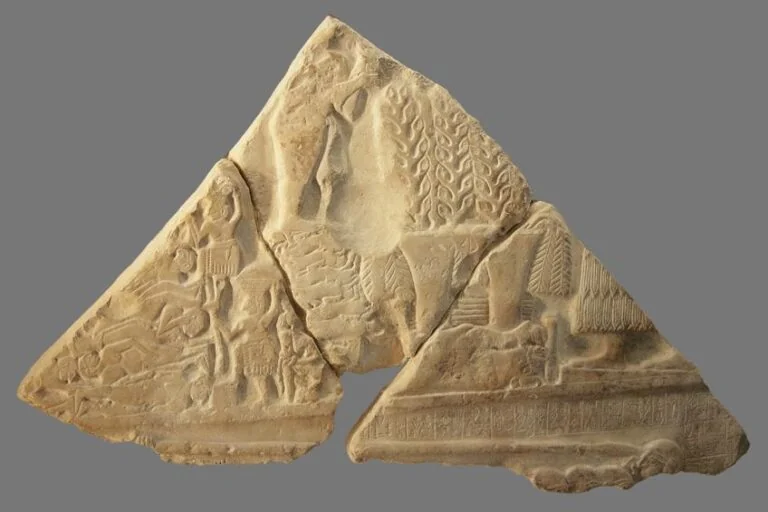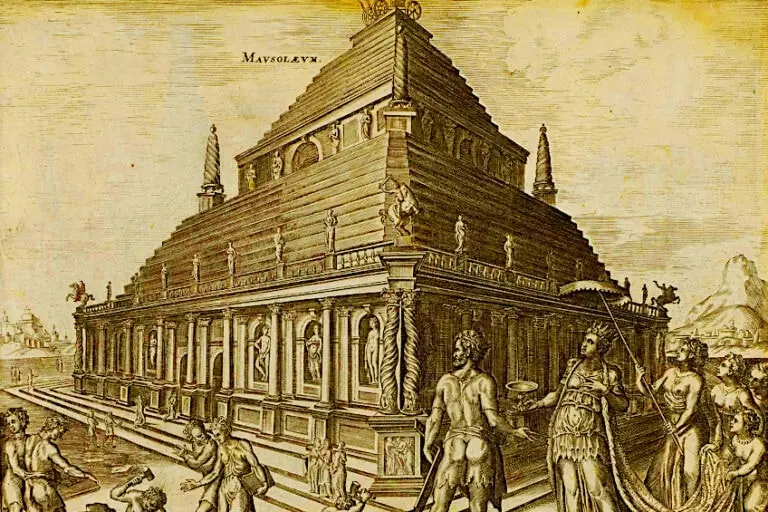Gateway Arch – When was the St Louis Arch Built?
When you think about historical structures, it’s easy for your mind to drift to images of things like the great Sphinx, the leaning tower of Pisa, or the churches in the Vatican. These are indeed incredible artifacts, but there are many more recent structures that are (arguably) more impressive due to their advanced architectural designs and their often-impressive aesthetics. A good example of the latter is the Gateway Arch. Let’s have a look at what exactly the Gateway Arch is, where it can be found, how it was made, who created it, and what state it’s in today.
Contents
What Is the Gateway Arch?
| Architect | Eero Saarinen |
| Size (h) | 192 meters |
| Location | St. Louis, Missouri, United States |
| Materials Used | Steel and concrete |
| Date of Creation | 28 October 1965 |
| Style of Architecture | Modern architectural style |
The gateway arch (also known as the arch in St. Louis) is a large archway that is found in the city of St. Louis, Missouri. This large arch sits along the bank of the Mississippi River and was constructed initially to draw tourists to the region. The arch also has a great symbolic meaning that dates back to the era of the westward expansion of the United States, earning the structure the nickname “the gateway to the west”.
The archway is one part of a larger attraction, the Gateway Arch National Park. This area as well as the arch was constructed to commemorate the Louisiana Purchase in the early 1900s in addition to the opening up of the Western Front to settlers after the famous Louis and Clarke Expedition. The national park the arch is situated in is also home to another important spot.
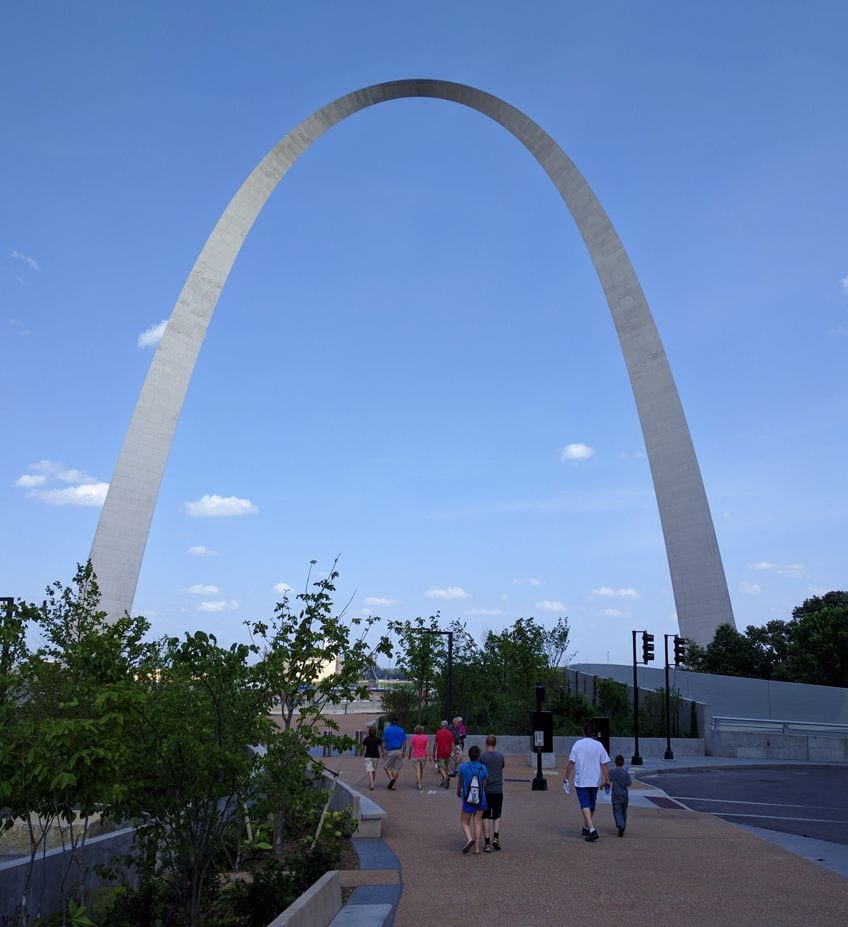 Gateway Arch, St. Louis (1965); Lewis Hulbert, CC BY-SA 4.0, via Wikimedia Commons
Gateway Arch, St. Louis (1965); Lewis Hulbert, CC BY-SA 4.0, via Wikimedia Commons
The Gateway National Park is also home to the courthouse where Dred Scott sued for his freedom. If you’re unaware, Dredd Scott and his wife were the first slaves to sue for their freedom, and even though the case was taken all the way up to the supreme court, their efforts were, unfortunately, unsuccessful. However, the location has been immortalized. The arch in St. Louis is 630 feet (or 192 meters) high and measures the same width. These dimensions make St. Louis arch the tallest monument in the United States.
The construction of this monument took four years, beginning in 161 and reaching its completion in 1985, on the 28th of October that year.
The St. Louis Arch Tram System
Unlike many large-scale construction projects that had taken place in the past, the construction of the arch in St. Louis was completed with no loss of life, a monumental achievement considering the prestige of the structure, not to mention that it’s still the tallest structure in the continental United States today.
The arch isn’t just pretty to look at either, as, unlike other structures of its size, you can climb all the way to the top! “Climb” might be a bit misleading, though, but you can take a tram to the top of the tallest structure in North America to experience the amazing views while having the opportunity to truly appreciate the grandiosity of the arch.
 St Louis Gateway Arch at Sunset (1965); Linda L Kung, CC BY-SA 4.0, via Wikimedia Commons
St Louis Gateway Arch at Sunset (1965); Linda L Kung, CC BY-SA 4.0, via Wikimedia Commons
The tram system wasn’t always a feature though, as the tracks and carts were only added once construction was completed back in 1967. The tram and the infrastructure associated with it are reported to have cost $2,000,000 in total, and the total cost of the arch’s construction is recorded to have cost $13,000,00 in labor. In retrospect, it seems that this was all money well spent considering that the site attracts over 6,700 eager visitors in a single day, who get to enjoy a presumably heart-pounding four-minute tram trip to the top of the arch.
If heights make you uneasy, rest assured that the foundations of the structure extend 60 feet (18.2 meters) underground, and are capable of swaying up to 18 inches (46 millimeters) if need be.
The Gateway Arch History
While the St. Louis arch is impressive to look at, the reason the site was built, to begin with, is interesting as well. As we mentioned previously, the arch was constructed to commemorate the Louisiana purchase which was famously negotiated by Thomas Jefferson. It also stands as a reminder of the diverse group of people that formed the modern United States after its borders were quite literally doubled following the Louisiana purchase.
The arch was initially known as the Jefferson National Expansion Arch before it was eventually changed to fit a more holistic description of why it was constructed in the first place. The symbolism of the arch is considered to resemble the pioneering spirit, reaching high up into the sky and creating something incredible with your fellow countrymen.
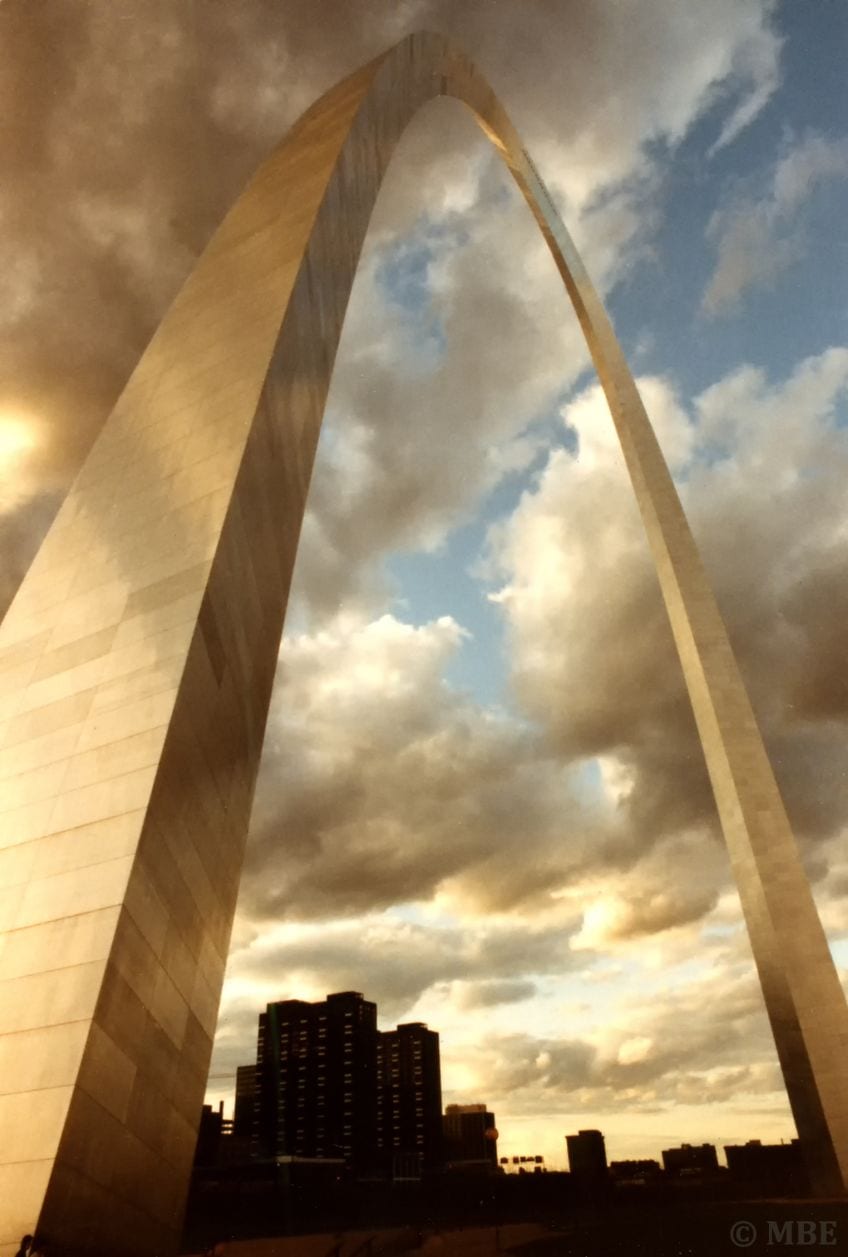 St. Louis Arch (1965); Dwaynep2018, CC BY-SA 4.0, via Wikimedia Commons
St. Louis Arch (1965); Dwaynep2018, CC BY-SA 4.0, via Wikimedia Commons
The idea for this monument was first brought about when former President Roosevelt sought to designate property in the area to commemorate the expansion of the United States back in 1937. The land was eventually designated for the purpose of the memorial, but there were various instances of litigation against the project, much of which ended in landowners being paid out for the acquisition of their property. Once the land was acquired the deed to the historic courthouse was handed over to the National Park Service, who today are responsible for the upkeep of the demarcated area and the courthouse itself.
This structure along with the surrounding lands would eventually be incorporated into the national memorial we all know today.
The Gateway Arch Design Competition
One of the most interesting facets of gateway arch history is the design competition that took place to determine its final look. This was a nationwide context that started in the year 1948 and would only conclude years later. After what is presumed to be much deliberation, the design of architect Eero Saarinen was chosen as the winner.
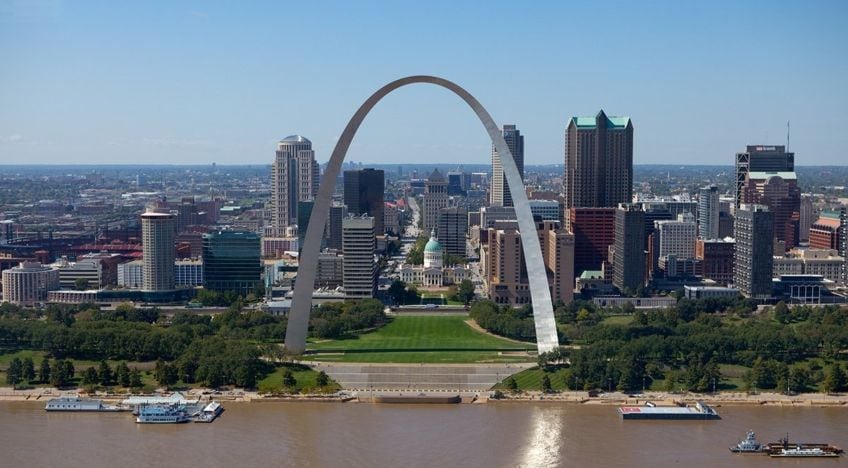 Gateway Arch – St. Louis – Missouri (1965); Sam valadi, CC BY 2.0, via Wikimedia Commons
Gateway Arch – St. Louis – Missouri (1965); Sam valadi, CC BY 2.0, via Wikimedia Commons
The construction of Saarinen’s design began in 1964, and as we can see today the architect’s hard work and dedication paid off in spades! The St. Louis arch has become an iconic part of the Missouri skyline and provides many citizens with a strong sense of national identity and pride despite the challenges that were faced during the years of expansion.
The Courthouse and the Dredd Scott Case
As we mentioned previously, the courthouse located on the property would be overseen by the National Park Service as a type of civil rights monument due to the number of extremely important civil rights cases that took place there. One of the best examples of these cases is the famous Dredd Scott case, in which an enslaved man (Dredd Scott) and his wife (Harriet) sought to sue the state for their freedom. The case centered around the fact that Scott was taken to free territory in the state of both Illinois and Wisconsin and subsequently brought back to the state of Missouri where he was once again enslaved along with his wife.
The final outcome of the case resulted in a failure, with the court ruling that African American people were not considered citizens of the United States at the time.
While the case might have not resulted in the freedom of Scott and his wife, the blatant disregard for the lives of both of them resulted in the civil rights movement receiving a much-needed increase in speed. This would eventually result in the desegregation of public spaces and the recognition of the citizenship of all African Americans.
The Design of the St. Louis Arch
As we mentioned previously the design of the arch was a result of a competition, in which one Eero Saarinen won the competition, beating out 171 other submissions and earning himself the honor of designing the famous monument. The design brief stated that the overall structure was to serve as a living monument to the legacy of Thomas Jefferson through the ages.
The final design was meant to represent Jefferson’s dream of better opportunities for men of all races and creeds. The final design essentially functioned as a gateway to the West and a reminder of the great expansion that was afforded to the people thanks to the purchase of said land. This is further symbolized by the fact that the monument overlooks the river.
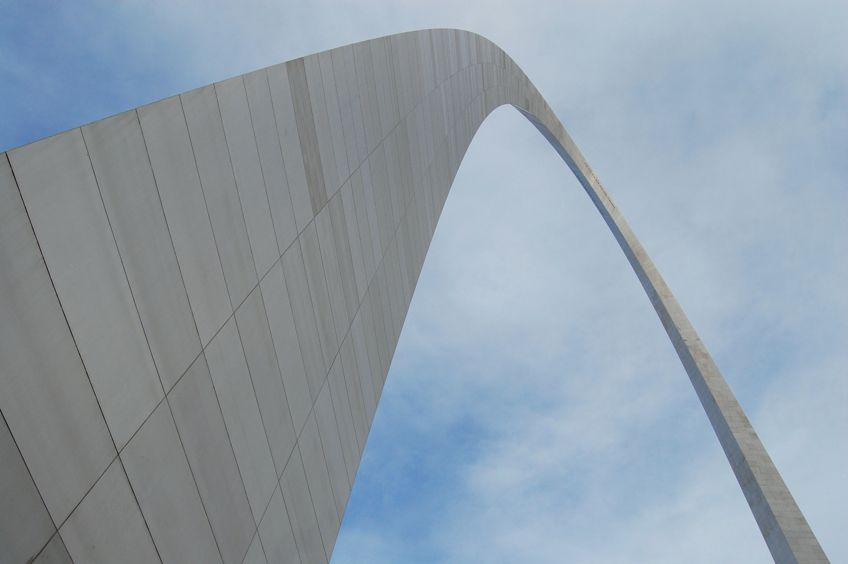 St Louis Gateway Arch Extreme Closeup (1965); Linda L Kung, CC BY-SA 4.0, via Wikimedia Commons
St Louis Gateway Arch Extreme Closeup (1965); Linda L Kung, CC BY-SA 4.0, via Wikimedia Commons
As with most great monuments, the St. Louis arch began with a relatively simple concept. Saarinen’s design is based on a catenary curve, a form that is created when a chain is suspended by being held at both end links. This gentle curve is immediately visible upon viewing the monument, truly emphasizing the beauty of the simplistic design.
Construction of the Arch
During the construction phase that took place in the 1960s, there were many companies that were invited to bid on the construction of the arch. The city allowed for an absolute bidding threshold of $12,765,078. Of the four bids that were chosen, all of them were far greater than what the head engineer had projected by around $3.500,000.
Once all of the bids were in, the validity of the bids was assessed, and at the end of the process, the contract for the construction of the St. Louis arch was awarded to the lowest bidder, a company by the name of MacDonald Construction Co. of St. Louis.
This deal was struck on the 14th of march in 1962, after which the company received $2.5,000,000 as part of the city’s subsidy for this phase of construction.
Between the years 1959 and 1960 ground was officially broken on the construction effort. This phase included the laying of the foundation and the transportation of the many steel triangles that make up the arch. The triangles were prefabricated, transported on site, and then raised by cranes to place them (and join them) where needed.
The entire structure consists of 142 individual pieces that are around 12 feet in length (or around 3.4 meters). Each section of the arch is double-walled and is filled with cement, all of which have been prestressed with steel bars which number well over 252. While the legs of the arch were still independent of one another a scissor Struss was placed between them in order to stabilize the structures.
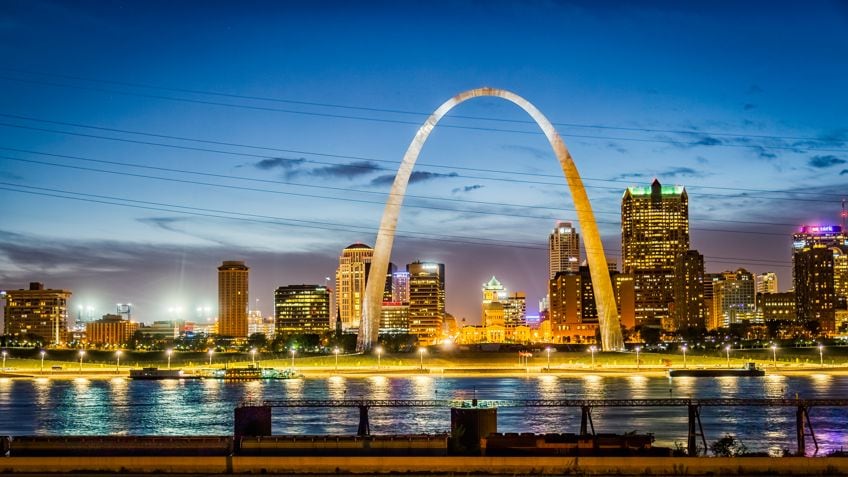 Gateway Arch St. Louis from Illinois (1965); Mobilus In Mobili, CC BY-SA 2.0, via Wikimedia Commons
Gateway Arch St. Louis from Illinois (1965); Mobilus In Mobili, CC BY-SA 2.0, via Wikimedia Commons
McDonald’s construction was quite proud of the endeavor they were undertaking, and to show the public exactly what they were up to, McDonald created a 30-foot spectator stand on which the public could monitor the entire process in real time. Throughout the 1960s radio broadcasters and photojournalists documented every phase of the production process, not to mention the fact that the McDonald’s team kept their own detailed record of the development. Reynold Ferguson is arguably the most well-known of any reporters who covered the construction process, as he was permanently assigned to the project and was allowed complete access to the site.
He even went as far as to walk the dangerous catwalks with the construction crew, where he obtained incredible panoramic photographs of the site, which are now on display at the State Historical Society of Missouri.
Additional Attractions
While the reason behind the construction of the arch was to memorialize the expansion of the United States, these days it functions as more of a tourist attraction. The tram is the main draw, whizzing you up 100 feet into the air and providing you with a view of the entire city, but it isn’t the only attraction in the area.
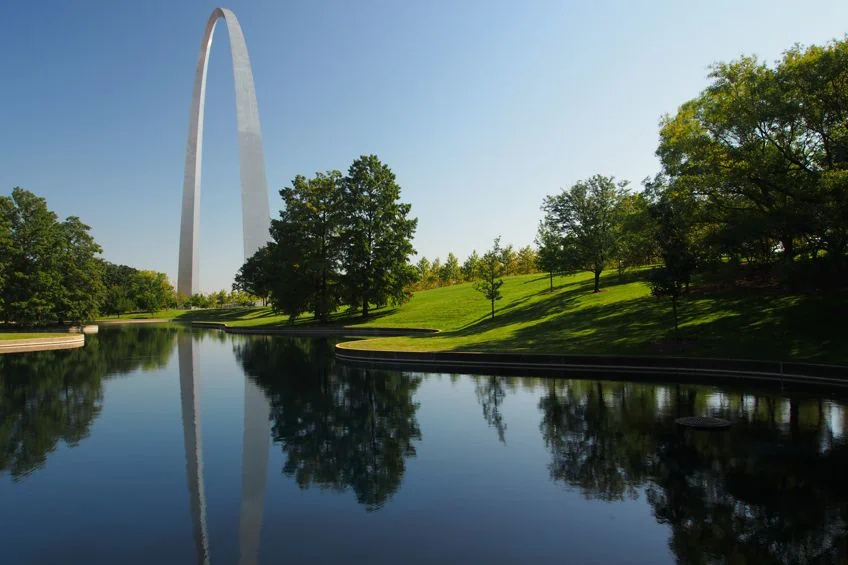 The Gateway Arch seen across the south reflecting pond in the National Park (1965); Daniel Haim, CC BY-SA 4.0, via Wikimedia Commons
The Gateway Arch seen across the south reflecting pond in the National Park (1965); Daniel Haim, CC BY-SA 4.0, via Wikimedia Commons
At the base of the arch, there is a museum known as the Museum of Western Expansion that allows you to immerse yourself in the lifestyle of those who lived in the 1800s This likely serves as a reminder of why the arch exists in the first place, as well as how far the American people have come and what they’re capable of when they put their minds to it.
Now that you know what the St. Louis arch is, where it is located, how it was built, what was used to make it, who created the initial concept, and what it has on offer today, it’s time for you to get out there and put your newfound knowledge to the test. If you have an opportunity to visit the arch, we recommend checking out both the museum at the foot of the arch and the famous courthouse!
Frequently Asked Questions
When Was the St. Louis Arch Built?
Throughout generations, people have visited the awe-inspiring St. Louis arch, but when was the St. Louis arch built? The arch was conceived and built during the 1960s, and construction finished in 1967, two years after its projected finishing date.
Where Is the Arch Located?
While the St. Louis arch is pretty hard to miss, it’s also easy to get lost, especially if you’re not from St. Louis. Where is the arch located then? The arch is located right next to the Mississippi River, but you shouldn’t have any trouble finding it considering that it’s the tallest structure in the United States!
What Is the Gateway Arch Height?
When first seeing the arch, it can be a lot to take in due to the sheer size of the structure. This can leave you with a lot of questions, with one of the most common being how tall it is. What is the St. Louis arch height then? The structure is 192 meters tall at its apex and is equally as wide. The St. Louis arch’s height at the time of its construction made it the largest monument in the United States.

I am deeply passionate about history and am constantly fascinated by the rich and complex stories of the past. As the editor-in-chief of learning-history.com, I have the opportunity to share this passion with a wide audience through the creation and distribution of engaging and informative content about historical events, persons, and cultures. Whether it’s through writing articles and blog posts or creating videos or podcasts, I strive to bring the past to life in a way that is both accurate and enjoyable. My expertise in history, combined with my strong writing and communication skills, allows me to effectively communicate complex historical concepts and make them accessible and interesting to a wide range of readers. I am truly grateful for the opportunity to share my love of history with others through my work on learning-history.com.

